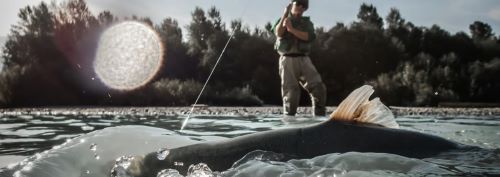In odd-numbered years, millions of pink salmon make their journey back into the rivers of Southern B.C. starting in mid-August. Anglers both young and old, novice and experienced, enjoy fishing for pinks (or “humpies”) because they are plentiful and aggressive biters. On warm, sunny September days, what’s not to love about this popular fishery?
Weighing between three and six pounds (1.4 and 2.7 kilograms), pink salmon are the smallest of the five Pacific salmon species. This is due to their short life cycle. After hatching, they immediately begin migrating into the ocean. Spending just over one year in the sea, they return as adults to complete their life cycle.
Pink Salmon Run Timing
Pink salmon generally start arriving in the Fraser River during mid-August, though the bulk of the run appears in the first two weeks of September. It tapers off by the end of the third week of September. In 2023, openings have been provided for both the tidal and non-tidal portions of the Fraser River, Chilliwack River, Harrison River and Stave River in September. Please check the opening dates and limits before heading out.
Knowing the tide is extremely important when taking part in the Lower Fraser pink salmon fisheries. During incoming tides, hundreds of thousands of pink salmon would migrate from the Fraser River mouth to tributaries. The best time to target them usually starts three hours before the tide peaks until it begins to ebb. Your key to success is not only being at the best fishing spot, but also determining the portion of the tide that’s most productive.
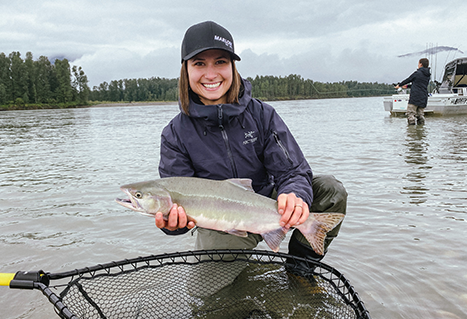
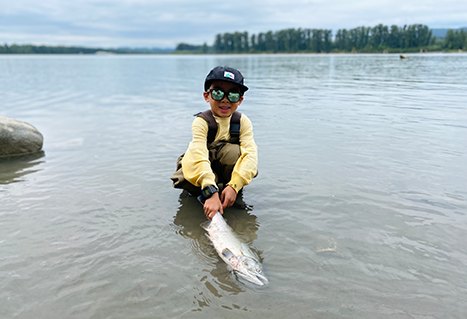
Fishing Methods for Pink Salmon
Casting spoons or spinners
Casting and retrieving a spoon or spinner is the most popular angling method. Since pink salmon generally weigh less than six pounds (2.7 kilograms), a light spinning tackle setup is adequate to handle them. A six- to eight-foot (1.8- to 2.4-metre) long spinning rod rated for four- to 10-pound test line, matched with a light spinning reel spooled with either six- or eight-pound test monofilament, offers the best performance.
Spincasting
Spincasting is effective in waters with slower currents. A spoon, spinner or jig which weighs around 1/4oz is ideal for this technique. For lures, the general rule is ‘pink for pinks’. Try using almost any small lure with some pink or red on it. After casting, allow the lure to sink for several seconds before retrieving. If there are fish around, get ready to feel that tug on your rod tip! If you miss hooking a fish, continue retrieving; pink salmon will often return to attack the lure again. Other colours which work well include chartreuse, orange, or even a plain silver lure.
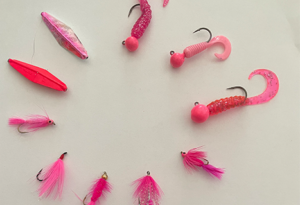
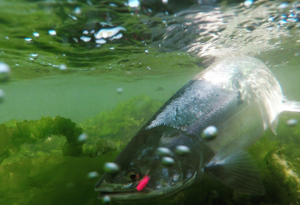
Fly-fishing
You can also fly-fish in these same slower waters. Small pink, orange, or chartreuse streamer patterns (in sizes 4 to 6) will all entice fish. A 5- or 6-weight setup is strong enough. If there is no river current, a weighted fly at the end of a 10-foot (three-metre) leader behind a floating fly-line is all you need. Allow the fly to sink for some time before stripping it in rapidly. If the current is stronger, you may consider switching to an intermediate sinking line to keep the fly in the strike zone. The key is to have your fly suspended in the water just above the school of fish. When fishing in rivers, avoid having your fly drag along the bottom – you may end up snagging either the riverbed or, very unsportsmanlike, fish.
Float-fishing
In faster flowing rivers like the Chilliwack, you should use a float-fishing setup. A baitcasting or centrepin rod between nine and 11 feet (2.7 and 3.4 metres) long can accomplish this task. The most effective lure to tie onto the end of your line under the fishing float is a jig head. If a school of humpies is holding in a run, a jig head (dressed with either pink feathers or a rubber worm) can almost guarantee fish on every cast. For the best results, adjust your line below the float so the jig is drifting one or two feet (0.3 to 0.6 metres) above the riverbed. Keep your eyes on that float, which may disappear anytime as it travels downstream!
Licensing requirements for salmon fishing
Before heading out, make sure that you have a valid fishing licence (freshwater or tidal water), and if you intend to keep any salmon caught, then you will need to purchase a salmon conservation surcharge stamp for your licence. Also check the daily quota, size limits, and other regulations for the area where you are fishing. The management of salmon fisheries in B.C., in both tidal and fresh waters, is the responsibility of the federal Department of Fisheries and Oceans (DFO). The regulations for salmon fishing in fresh water are not included in the Freshwater Fishing Regulations Synopsis, but are available from any DFO Office or through the on-line Freshwater Salmon Supplement on DFO’s website.
Freshly caught pink salmon can be extremely tasty when prepared correctly. Grilled on a barbecue, deep-fried in batter, cut into cubes and stir-fried, stuffed and baked, or smoked, these small but scrappy battlers are delicious. The Fraser River’s pink salmon fishery is often a social gathering. Be sure to experience it with your family or a group of friends.
Author: Rodney Hsu.
